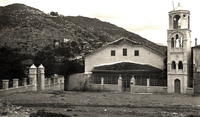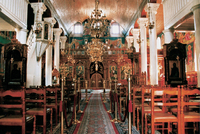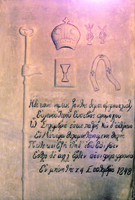Church of John the Baptist


View of the Metropolitan Church, around 1933, during the reconstruction phase of the square. Architectural description: The temple architecturally is a three-aisled basilica of the type known in the 19th century, during the Ottoman Empire. On the outside of the church you can see forged, heavy iron bars on the windows, and various embossed symbols carved in marble or sandstone. The doorframes, at all openings, made of reddish stone, from Mandra area. Notice one of the carvings, which is on the east side, and is situated in a semicircular arc. It was build with small, wedge stones, voussoirs, with two different materials and colors, white and red. In the carving you can read the initials of the name of Christ and the date of construction of the temple. On the east side, cornices, windows and arch are decorated with indigo chevron. All these elements, the focus color (voussoirs, braid), the volume of the sanctuary and dating in the carving confers sovereignty of this aspect in relation to the rest of the church, as was customary to prevail in Byzantine times. The west façade, main entrance of the church, is adorned only by a newer loggia, while the other sides, the north and the south, are unadorned. Inside the church there is a modern, wooden templon and the bishop's throne,pulpit.There is also a women place, on the west side, on a floor, which had previously,particular, latticed grids. One of the most noticeable icons of the temple is the most treasured icon of the Nativity of John the Baptist, which dates from 1841 and is the work of the famous, Mount Athos painter Ioasaf. Other important icons, painted by the same painter and decorating the church are: Christ, Mother of God, John the Baptist, the Annunciation and Saint Charalambos. The Icon of the martyr St. George from Ioannina is a proof, except for the dissemination of the honour of a new and popular saint in Xanthi, of Epirus presence in the city. Interestingly, the performance of the young saint, is reminiscent of King Otto. The icon is a work of Philip the painter, and was created in 1863. On the south wall, inside the church a gravestone is built in memory of Bishop Eugene, who died in 1848. The interesting carved designs, the pontifical bar, the miter, the Dikirion and trikirion, the small scapular and the Holy Grail are all badges of the episcopal office . The Church celebrates on August 29, in memory of the ablation of the head of the Holy, Glorious Prophet, and Baptist John, the patron saint of the city. On August 28, the church celebrates the Great Vespers. Then, the procession of the Holy Icon takes place, in the central city streets, up to the main square, where,the Celebration Speech is given by the Bishop of Xanthi and Peritheorio.





















